Source
A Report by ‘Research Foundation for Science, Technology and Ecology’ for National Commission for Women, January, 2005, Page 01-10.
Women are the water providers in India. In villagers, they walk long miles and in cities theywait long hours to bring water for the drinking and cleaning needs of their families. The water crisis translates into an increasing burden for women as water providers. And with increasing water scarcity and water pollution, water related diseases increase women as care givers also carry a disproportionate the burden of water borne diseases.
150 Million Woman Days and Rs. 10 Billion Loss Every year in Fetching water
To get a bucket of drinking water is a struggle for most women in the country. The virtually dry and dead water resources have lead to acute water scarcity, affecting the socio-economic condition of the society. The drought conditions have pushed villagers to move to cities in search of jobs. Whereas women and girls are trudging still further. This time lost in fetching water can very well translate into financial gains, leading to a better life for the family. If opportunity costs were taken into account, it would be clear that in most rural areas, households are paying far more for water supply than the often-normal rates charged in urban areas. Also if this cost of fetching water which is almost equivalent to 150 million women day each year, is covered into a loss for the national exchequer it translates into a whopping 10 billion rupees per year.
In India, there are many villages either with scarce water supply or without any source of water. If there is no source of potable water in 2.5 kilometres, then the village becomes no source water village or problem village. In many rural areas, women still have to walka distance of about 2.5 kms to reach up to the source of water. She reaches home carrying heavy pots, not to rest but to do other household chores of cooking, washing, cleaning, caring of children and looking after livestock. Again in the evening she has to fetch water.Thus a rural woman’s life has become sheer drudgery for lack of water.
Further variations in ground water levels are also causing changes in water quality resulting in an increase in disease. The status of water quality in rural habitation is given in the following table.
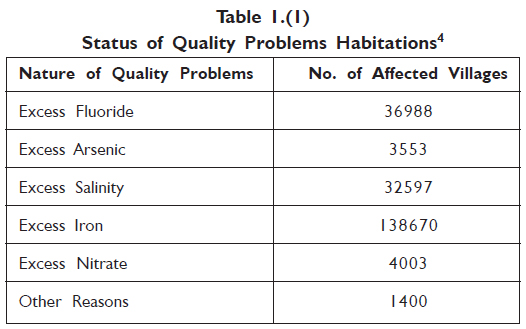 Although the Ministry of Rural Development claims more than 95% coverage, independent reports show scarcity of shrinking water in about half of the villages of India. What is even more distressing is the fact that this group has been increasing over the years, despite heavy investments. People died in India during the recent past, crying for water. And the problem is worsening day by day.
Although the Ministry of Rural Development claims more than 95% coverage, independent reports show scarcity of shrinking water in about half of the villages of India. What is even more distressing is the fact that this group has been increasing over the years, despite heavy investments. People died in India during the recent past, crying for water. And the problem is worsening day by day.In cities the problem is going to be more acute, as the population growth is spurring a demographic change, especially as towns become cities and cities become mega cities. This can be seen from the fact that the 23 million-plus cities in India in 1990 grew to 42in 2000 and are expected to grow to 63 by 2010. Also, there are serious concerns on the availability of fresh water, as India with 16 per cent of the world’s population has only 2.45 per cent of the world’s land resources and 4 per cent of the fresh water resources.The per capita availability of fresh water in the country has dropped from an acceptable 5,177 cubic metres in 1951 to 1,820 cubic metres in 2001. It is estimated that it would further decline to 1,341 cubic metres by 2025 and 1,140 cubic metres by 2050 (table 1.2).This is alarming as the threshold per capita value for water stress is 1,000 cubic metres. Total water availability is 1,122 billion cubic metres as shown in table 1. (3).
India ranks a poor 120 in a list of 122 countries ranked for their water quality as also their ability and commitments to improving its quality, in a World Water Development Report. In terms of water availability, India has not fared well. She is ranked a lowly 133 in a list of 180 countries. India’s neighbours, Bangladesh, Sri Lanka, Nepal and Pakistan have faredbetter than India, occupying the 40th, 64th, 78th and 80th slots respectively.
India’s population, recording a current annual increase by 15.5 million, has to inevitably face the greatest challenge of conservation and equitable distribution of the limited fresh water resources. And its management is inextricably intertwined with future growth and poverty alleviation.
As shown in table 1 (4), a study of 12 major cities reveals that while they require over 14,000 million litres of water a day, they get only 10,000 million litres. Due to water shortage, over 200 million people are vulnerable to water wars. In Neemuch (Madhya Pradesh), one person was killed and six injured in May 2003, when people fought for water with swords andknives. Such sporadic incidents could become routine.
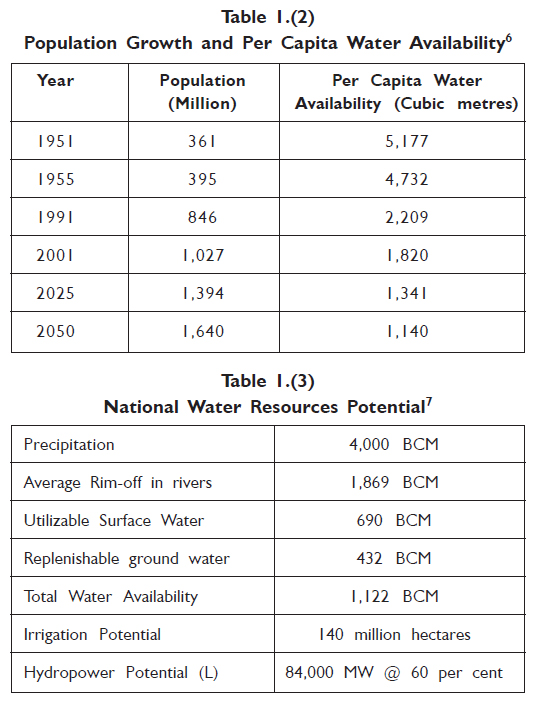
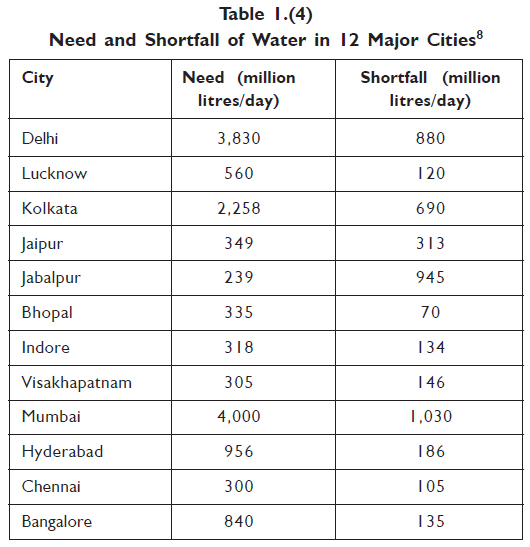 Water is the biggest crisis facing India in terms of spread and severity, affecting one in every three persons. Even in Chennai, Bangalore, Shimla and Delhi, water is being rationed and India’s food security is under threat. With the lives and livelihood of millions at risk, urban India is screaming for water. For instance, water is rationed twice a week in Bangalore,and for 30 minutes a day in Bhopal; 250 tankers make 2,250 trips to quench Chennai’s thirst. Mumbai routinely lives through water cuts from January to June, when some areas get water once in three days in Hyderabad.
Water is the biggest crisis facing India in terms of spread and severity, affecting one in every three persons. Even in Chennai, Bangalore, Shimla and Delhi, water is being rationed and India’s food security is under threat. With the lives and livelihood of millions at risk, urban India is screaming for water. For instance, water is rationed twice a week in Bangalore,and for 30 minutes a day in Bhopal; 250 tankers make 2,250 trips to quench Chennai’s thirst. Mumbai routinely lives through water cuts from January to June, when some areas get water once in three days in Hyderabad.Urban water privatisation is divorced from reality. It is obvious that the privatisation protagonists forgot to take into consideration the myriad complexities of the India’s Water Management System that are deeply embedded in the country’s society, politics andeconomy.
According to Prof. A. V. Vaidyanathan, water expert with Madras Institute of Development Studies in Chennai: “It is not correct to describe water as a commodity. It is a public utility which can be priced, but within certain socio-economic parameters.”
However, Municipal Corporations under the pressure of privatisation lobby have proposed a huge tariff hike (table 1. (5). For Delhi, the water cost will increase more than 10 times.
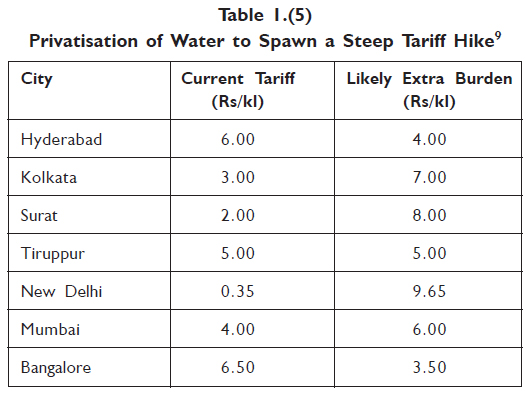 Contrary to popular perception, water shortage is not just an urban problem but is, in fact, worse in rural India, And as basins and rivers dry up, it also threatens the country’s food security. According to the data available with the Ministry of Water Resources, eightof the 20 river basins are water deficit, threatening the lives and livelihoods of over 200 million people.
Contrary to popular perception, water shortage is not just an urban problem but is, in fact, worse in rural India, And as basins and rivers dry up, it also threatens the country’s food security. According to the data available with the Ministry of Water Resources, eightof the 20 river basins are water deficit, threatening the lives and livelihoods of over 200 million people.Water precedes roti, kapada aur makan. The people of Antarnesh in Patan district of Gujarat still remember the pitiful sight of an eight-year old girl dying of thirst. Women had gone to collect gum from the trees. The child was thirsty but there was no water to give. Thewater source was 6 km away. She died crying for water.
According to Shabana Azmi, the actress and nominated Member of Parliament, when thegovernment social programme ran into a fierce opposition from the women, an NGO was called to break the impasse. When asked by the NGO, ‘what was their biggest problem?’ all the women in one voice said “water.” It turned out that they had to walk miles for water because their hand pumps had broken down and the men of the villages could not repair it.
Indeed, judicious use is what is needed. Also in many areas, it is not how to save more water, but how not to waste water. In urban India, 12 to 15 litres of water is flushed per use. Experts believe it should not be more than 5 litres as practised in some Western countries. Per household use of water should be brought down drastically. Also what is neededimmediately is to find out new cropping patterns to save water. For instance, rice and sugarcane are high water intensive crops and we must look for alternatives.
Besides the management of water supply, there is also the need for technology to increase efficiency. It is time India should shift from the concept of yield per hectare to yield per cubic metre of water.
The National Water Policy passed in 2002 also addresses some of the concerns of the three main stakeholders (rural, urban and industrial) and identifies measures for developing and conserving the nation’s water resources. In fact, to increase and optimise water availability in agriculture, it is important to use it optimally by adopting methods like water harvesting and recharging and recycling of water. Therefore, adopting modern techniques like deep and sprinkler irrigation would enable efficient utilization of the available water.
Water conservation programmes need to be initiated to generate awareness on conservation methodology by involving local communities. Industries also need to be encouraged to adopt the latest technologies available for effluent treatment. In urban areas, much water is lost due to technical losses by public water utilities.
About 70 per cent of the world’s water is used for growing crops. The agricultural sector in India is the single largest user of water resources accounting for as much as 80 per cent of the total annual withdrawals. With India having the highest irrigated area in the world at 55.14 million hectare, out of total 255.46 million hectare, there is an urgent need for the efficient use of the available water resources. Also, as the population increases, there will be greater need for augmenting food production to achieve food security, and this in turn puts greater pressure on water supply for irrigation.
Looking 30 years into the future, FAO estimated that feeding the world’s population would require 60 per cent more food. Most of this increase will have to come from intensified agriculture, supported by irrigation. But water is already scarce in many countries and competition for water from industrial and domestic users continues to grow.
In irrigation, it is estimated that more than 60 per cent of the water seeps from the distribution channels and is lost by evaporation. Moreover, seepage causes water logging and salinisation in irrigated lands, resulting in significant reduction of crop yield. And also, the rainfall shows great variation, unequal seasonal distribution as well as unequal geographical distribution and frequent departures from the normal. As much as 21 per cent of the area of the country receive less than 750 mm of rain annually while 15 per cent receive rainfall in excess of 1500 mm. Annual rainfall of less than 500 mm is experienced in Western Rajasthan and adjoining parts of Gujarat, Haryana and Punjab. This shows the need for undertaking the measures, which are water prudent.
Ground water today supplies as much as 80 per cent of the domestic water supply in rural areas and around 50 per cent of the urban and industrial needs. As per estimates, over 70 per cent of the value of irrigated products could depend on ground water resources. Ground water is said to contribute 51 per cent of the irrigation potential created in the country through more than four million dug wells, five million shallow tube wells and some nine thousand public tube wells. The over exploitation of ground water is leading to a drop in ground water levels in many parts of the country.
According to forecasts by the Ministry of Water Resources and presentations by the Ministry of Agriculture, 11 river basins including the Ganga will be water deficit by 2025, threatening 900 million lives. The symptoms are already visible. Tungabhadra river, fed by the high rainfall catchment area of the Sahayadri range, has already gone dry, but is not yet put on the list of deficit basins.
Instead of focusing on long-term solutions, every government has found it easier to allow exploitation of groundwater. While for the government it meant less investment, for the farmer it was free water to irrigate his land. True, India’s food security was propelled by the “tube well revolution,” but it led to long-term damage as the pump culture has wrought havoc on the hydrological cycle. Groundwater levels have plunged in 206 districts in the country. Nine States, including Rajasthan, Maharashtra, Gujarat, Haryana, Karnataka and Punjab, are facing major water deficits, where demand exceeds supply. With 3.5 million hand pumps and 56 lakh tube wells in operations, pumping of underground water is now nearly double the rate of aquifer recharge from rainfall.
With in next two or three decades, water problem in India may constitute a greater crisis than does energy today. The major difference between the water and energy crisis is that there are no known substitutes for water in satisfying direct demands by people, but there are many known substitutes for petroleum in producing energy. Similarities between the present energy crisis and the expected water crisis emphasis on increasing scarcities and increasing costs. Thus increasing costs and scarcity of water is likely to bring profound effects upon economic progress, employment, income distribution, investment and debt.
The total quantity of water for example may be abundant, but we may not have available sufficient water of a particular use demand. The water may be too salty, too toxic for particular use, one answer was implied in the words of Coleridges’, ancient mariner who while dying from the thirst lamented “water, water every where but not a drop to drink”. This answer concerns water quality. The ancient mariner was served well by the transportation services of the ocean water that carried by ship, but the same water did not posses the quality to quench the thirst.
Global consumption of freshwater increased six fold during 1900-95, at a faster rate greater than twice the rate of population growth. And if present trend continues two out of every three people on earth will have to live in water stressed condition by the year 2025. A recent World Water Development Report corroborates this. About 20 per cent of the world’s populations do not have access to safe drinking water and 40 per cent do not have sufficient water for adequate living and hygiene. The report expects that by 2050, water scarcity will affect 2 to 7 billion people out of total 9.3 billion, depending on factors like population growth and measures taken by political leaders to tackle the crisis. The report also found that more than 2.2 million people die each year from diseases related to contaminated drinking water and poor living conditions, faced with water scarcity.
If we have to halve the number of people without access to safe water and sanitation by 2015, according to the Millennium Development Goals of the United Nations, the world will have to spend up to $180 billion annually, more than double that is spent today.
Water has become the most commercial product of the 21st century. This may sound bizarre, but true. In fact, what water is to the 21st century, oil was to the 20th century. The stress on the multiple water resources is a result of a multitude of factors. On the one hand, the rapidly rising population and changing lifestyles have increased the need for fresh water. On the other hand, intense competitions among users-agriculture, industry and domestic sector is pushing the ground water table deeper.
The government has accorded the highest priority to rural drinking water for ensuring universal access as a part of policy framework to achieve the goal of reaching the unreached. Despite the installation of more than 3.5 million hand pumps and over 116 thousand piped water supply schemes, in many parts of the country, the people face water scarcity almost every year there by meaning that our water supply system are failing to sustain despite huge investments.
The situation is grave in 7% of the country’s area where the ground depletion exceeds 85% of the annual replenishable recharge. Besides, it has reached the critical stage in 11% of the area where over 65% of the ground water is depleted. The major impact may be seen in Rajasthan, Gujarat, Andhra Pradesh, Tamil Nadu, Karnataka, Madhya Pradesh, Orissa and Haryana. In general, the demand for fresh water from different sectors has been growing against a finite available quantity, resulting in scarcity situation spread over 1203863 sq. kms in 1205 blocks of 223 desert and drought prone districts.
Further a study shows that per capita availability of water, which was around 5177 cubic meters per year in 1951, has drastically fallen to 1869 cubic meter per year in 2001. It is likely to fall further to 1341 cubic meters in 2025 and in 2050 it will be 1140 cubic meters. It is generally presumed that if per capita level falls to 1000 cubic meters, it could seriously affect the health and economic activity of the entire country. At this level water crisis will be seen in 25% of India’s geographical area, affecting 21% of the total population. Already 5.5% of the country’s geographical area and 7.6% of the population are facing acute water shortages, with availability less than 500 cubic meters.

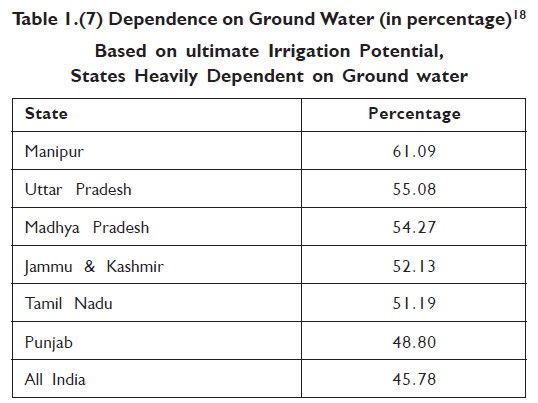 Table-1.(6) shows the details of the current water requirements for domestic and irrigation purpose, as also projects the demand for water in the years 2010 and 2025 and table –1.(7) shows the dependence of different states on ground water.
Table-1.(6) shows the details of the current water requirements for domestic and irrigation purpose, as also projects the demand for water in the years 2010 and 2025 and table –1.(7) shows the dependence of different states on ground water.Norms for Safe Drinking Water for Rural Population
The following norms have been adopted for providing safe drinking water to rural population.
(a) 40 liters of safe drinking water per capita per day (lpcd) for human beings
(b) 30 lpcd additional for cattle in the desert development programme area.
(c) One hand pump or stand post for every 250 persons
(d) The water source should exist within the habitation or within 1.6 kms in the plains and within 100 meters elevation in the hilly areas.
A brief description of major sources of drinking water in the rural areas in given below:
Tap
The figure in the Census of India 2001 bear out the anguish expressed by the Planning Commission. Only 70 million households have reported tap as their source of drinking water. These constitute a more 37% of the total households. At the national level, there has been an increase of just 14% in the use of tap water as a source of drinking water in the past two decades. Moreover the pace of growth is slowing. The trend in rural areas indicates only three percent increase in the year 1991-2001. Large states such as Bihar, UP, Assam and Orissa registered a decline in the proportion of households having access to tap water during 1991- 2001.
It is a matter of concern that only six major states – Haryana, Gujarat, Maharashtra, Andhra Pradesh, Karnataka and Tamil Nadu have reported the figure above national average. If the analyses are taken further almost 20% of the districts of India have less than 10% of households served by tap.
Census Data On Drinking Water Sources
32 million people are away from the source The Census data sheets. (Drinking Water Sources & Location and improvements in Sources of Drinking Water, 1981- 2001, A Perspective) published by census of India says, “It is alarming that even at the commencement of twenty first century, about 32 million households at national level are dependent for drinking water on the sources away from the premises”, i.e the source location is over 100 metre away from the premises in the case of urban areas and over 500 metre in the case of rural areas.

Hand Pump and Tube Well
This source of drinking water is considered next to tap in terms of potability. The usage of hand pumps/tube wells increased from about 15% in 1981 to 41% in 2001. In the North, there is preponderance of this source in Punjab, Uttar Pradesh and Bihar. In Haryana and Rajasthan, it rose from one in four households in 1991 to around one in three households, in 2001. In the South, Andhra Pradesh, Karnataka and Tamil Nadu this dependency appears to have somewhat slowed down during 1991-2001 – a pointer to the depletion of ground water sources.
It is important to note that even on the urban areas, two out of three households in Bihar, two out of five households in Uttar Pradesh and Assam and one out of three households in Punjab and West Bengal meet their requirements from these sources.
The dependency on Hand pumps/Tubewells as drinking water sources slowed down somewhat in the Nineties. Possibly in response to depletion of groundwater levels. As a matter of fact, the census figures clearly shows table 1 (9) that even though groundwater still remains dominant drinking water source at 59.5% in 2001. The dependency on groundwater has come down from 62.2% and 66.9% in 1991 and 1981 respectively. One lacuna with these figures is that some of the tap water comes from groundwater sources, but the Census figures not give division of figures in this respect. Still, even in urban areas, two out of three households in Bihar, two out of five households in UP and Assam and one out of three households in Punjab and West Bengal depend on this source of drinking water.
Wells
There has been a dramatic fall in the proportion of households depending on well as a source of drinking water. At the national level, around 18% of the household relied on well water in 2001 against 52% in 1981 –a decline of about 34% in two decades. There has been a decline in the dependence on wells in all the states and union territories, where status quo has been maintained.
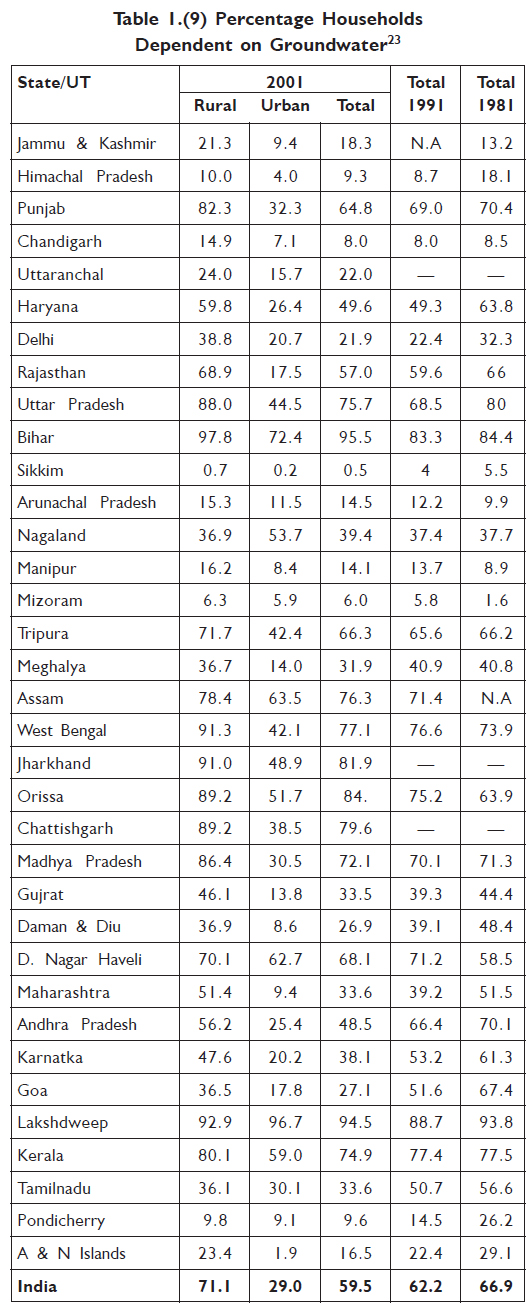 The most remarkable shift from well is observed in Uttar Pradesh and Bihar where only one in nine households depend on this source as compared to one in three households in 1991. In states like, Madhya Pradesh, Rajasthan and Orissa, one in four households still depends on wells for their daily requirement of drinking water.
The most remarkable shift from well is observed in Uttar Pradesh and Bihar where only one in nine households depend on this source as compared to one in three households in 1991. In states like, Madhya Pradesh, Rajasthan and Orissa, one in four households still depends on wells for their daily requirement of drinking water.Other Sources : It is a stark fact that 4% of the households in the country or 8 million households still depend on these sources, such as rivers, canals, ponds, lakes and the like which are considered unpotable.
Despite the high priority from the government, the problem of potable drinking water has remained unresolved and is in fact become more serious every year.
Women bear a disproportionate burden of water scarcity and water pollution. Even though women in the past have been the conservers and guardians of water resources along with land resources, today it is an imperative that women participate in water management, to ensure provisions for safe and adequate water. Policies must encourage women to participate in decision-making in matters regarding distribution, conservation and use of water in their region.
This is of prime importance in view of:
1. Women’s lack of time and energy affects selection of water sources and can limit availability of safe water at home and in the fields
2. The high time and energy cost of fetching water govern women’s perceptions of the importance of hygiene and disease prevention
3. Control of water has class and gender dimensions affecting all aspects of women’s lives
4. The stigma attached to water-borne diseases such as urinary schistosomiasis in women affects their own health seeking behaviour and their access to health care
5. Social factors such as these contribute to underreporting or urinary schistosomiasis in women
6. The disabling effects of diseases such as schistosomiasis and guinea-worm hamper women’s performance of their multiple roles
7. This threatens the nutrition and health status of the whole family
8. Time and social pressures may lead to under – reporting of malaria in women and delays seeking treatment
9. Lowered immunity to malaria during pregnancy has important health implications for women and their fetuses
10. Exposure to cadmium may increase women’s risk of osteoporosis and other bone diseases
Women and the Water Crisis
“When there is water scarcity, women are the worst affected,” says Santokben Lakhabhai Kamaria, a village woman from Gujarat. “When there is no water in the villages, no crops grow. Men migrate to the cities for work and women are left to fend for themselves, old people, children and cattle.”
no income for women. In our region, income is from the sale of milk and ghee which goes to women directly the family gets nourishing food and financial security during other crisis. When there is no water, there is no fodder for cattle, there is no milk. Men go to far to cities and women have to go to far off and strange places to work, where they are often exploited and harassed,”
Seventy five year old Muttama from Tamil Nadu speaks of how the replacement of traditional water tanks with modern conservation systems disempowered women in her village, The traditional tanks gave women more time to do other things. Once the traditional tanks fell into disuse, women spend most of their time collecting water. “Today we have organized ourselves to revive these tanks. Twenty five per cent of labor for reviving these reservoirs comes from women, there is water underground and greenery over ground wherever we work.”
Another water conservation enthusiast, Shantaben, from Dador, Gujrat, formed an organization of women and built check dams, revived old ponds and even procured a solar pump to pump water to other villages.
Ramom Magasaysay award winner Rajendra Singh says,” To solve the country’s water problem, we have to first recharge the earth’s own resource, Women play an important part here.”
Voicing opposition against male control over water management, women said,” We are involved in bringing water from far off places, using it for cooking, cleaning, washing, feeding animals, looking after crops. But when it comes to taking decisions on water management, we are nowhere.
Who Decides Water Use Management and Ownership?
While women carry the water burden as water provides, they are excluded from decisions about how water will be used, how it will be distributed, how it will be managed, how it will be owned. These decisions are being increasingly made by International Financial Institutions like World Bank and ADB, and Multinational Corporations like Suez, Vivendi, Coca Cola etc.
The World Bank, WTO And Corporate Control Over Water
Giant water projects, in most cases, benefits the powerful and dispossess the weak. Even when such projects are publicity funded, their beneficiaries are mainly construction companies, industries, and commercial farmers. While privatisation is generally couched in rhetoric about the disappearing role of the state, what we actually see is increased state intervention in water policy, subverting community control over water resources. Policies imposed by the World Bank, and trade liberalization rules crafted by the World Trade Organization (WTO), are creating a sweeping culture of corporate-states all over the world.
The World Bank: An Instrument for Corporate Control Over Water
Not only has the World Bank played a major role in the creation of water scarcity and pollution, it is now transforming that scarcity into a market opportunity for water corporations. The World Bank currently has outstanding commitments of about $20 billion in water projects, $4.8 billion of which are for urban water and sanitation, $1.7 billion for rural water schemes, $5.4 billion for irrigation, $1.7 billion for hydropower, and $3 billion for water-related environmental projects. South Asia receives 20 percent of World Bank water loans.
The World Bank estimates the potential water market at $1 trillion. After the collapse of the technology stocks, Fortune magazine identified the water business as the most profitable industry for investors. Large corporations, such as the biotech giant Monsanto, covert this lucrative market. Monsanto is currently plotting its entry into the water business and is anxiously eyeing the funding available from development agencies.
The erosion of water rights is now a global phenomenon. Since the early 1990s, ambitious, World Bank-driven privatization programs have emerged in Argentina, Chile, Mexico, Malaysia, and Nigeria. The Bank has also introduced privatization of water systems in India. In Chile, it has imposed a loan condition to guarantee a 33 percent profit margin to the French company Suez Lyonnaise des Eaux.
Not only does privatization affect people’s democratic right to water, it also affects the livelihoods and employment rights of those who work in municipalities and local water and sanitation systems. Public systems worldwide employ five to ten employees per 1,000 water connections, while private companies employ two to three employees per 1,000 water connections. In most Indian cities, municipal employees have resisted privatization of water and sanitation services.
The WTO disregards and even subverts hard-won victories such as the Indian Constitution. WTO is a tool to reverse the democratic decentralization to which diverse societies have been aspiring. WTO can challenge measures taken by central, regional, or local governments as well as nongovernmental bodies. Its rules are shaped entirely by corporations without any input from NGOs, local governments, or national governments.
The Water Giants
Water has become big business for global corporations, which see limitless markets in growing water scarcity and demand. The two major players in the water industry are the French companies Vivendi Environment and Suez Lyonnaise des Eaux, whose empires extend to 120 countries. Vivendi is the water giant, with a turnover of $17.1 billion. Suez had a turnover of $5.1 billion in 1996. Vivendi Environment is the “environmental services” arm of Vivendi Universal, a global media and communications conglomerate involved in television, film, publishing, music, the Internet, and telecommunication.
Vivendi Environment is engaged in water, waste management, energy, and transportation. In 2000, Vivendi Environment was awarded a 43-million-Euro contract for a wastewater treatment plan in Berne, Switzerland. Vivendi also has a 50-50 joint venture company called CTSE in the Czech Republic. Total net sales are expected to be 200 Euros. Vivendi’s subsidiary, Onyx, owns Waste Management Inc. Vivendi operates in several countries, including Hong Kong and Brazil.
Other water giants include the Spanish company, Aguas de Barcelona, which dominates Latin America, and the British companies Thames Water, Biwater, and United Utilities. Biwater was established in 1968 and given its name to reflect the company’s involvement in both the dirty-and clean-water businesses. Thames is owned by RWE, an electric company whose ventures include water.
Biwater and Thames have operations in Asia, South Africa, and the Americas. In the 1940s, Biwater entered Mexico and the Philippines. By the 1970s, it had contracts in Indonesia, Hong Kong, Iraq, Kenya, and Malawi. By 1992, the Biwater empire had expanded to Malaysia, Germany, and Poland. In 2000, the company. Cascal has contracts in the United Kingdom, Chile, the Philippines, Kazakhstan, Mexico, and South Africa. Another addition to the global water takeover is General Electric, which is working with the World Bank to crate an investment fund to privatize power and water worldwide.
Increasingly, the term “Water Providers” is being used not for the women who work to provide water, but for the water giants who take water from communities and sell it back to them at high cost for profit. The water traders, water profiteers are positioning themselves as “water providers” while increasing women’s burden in water provisioning.


